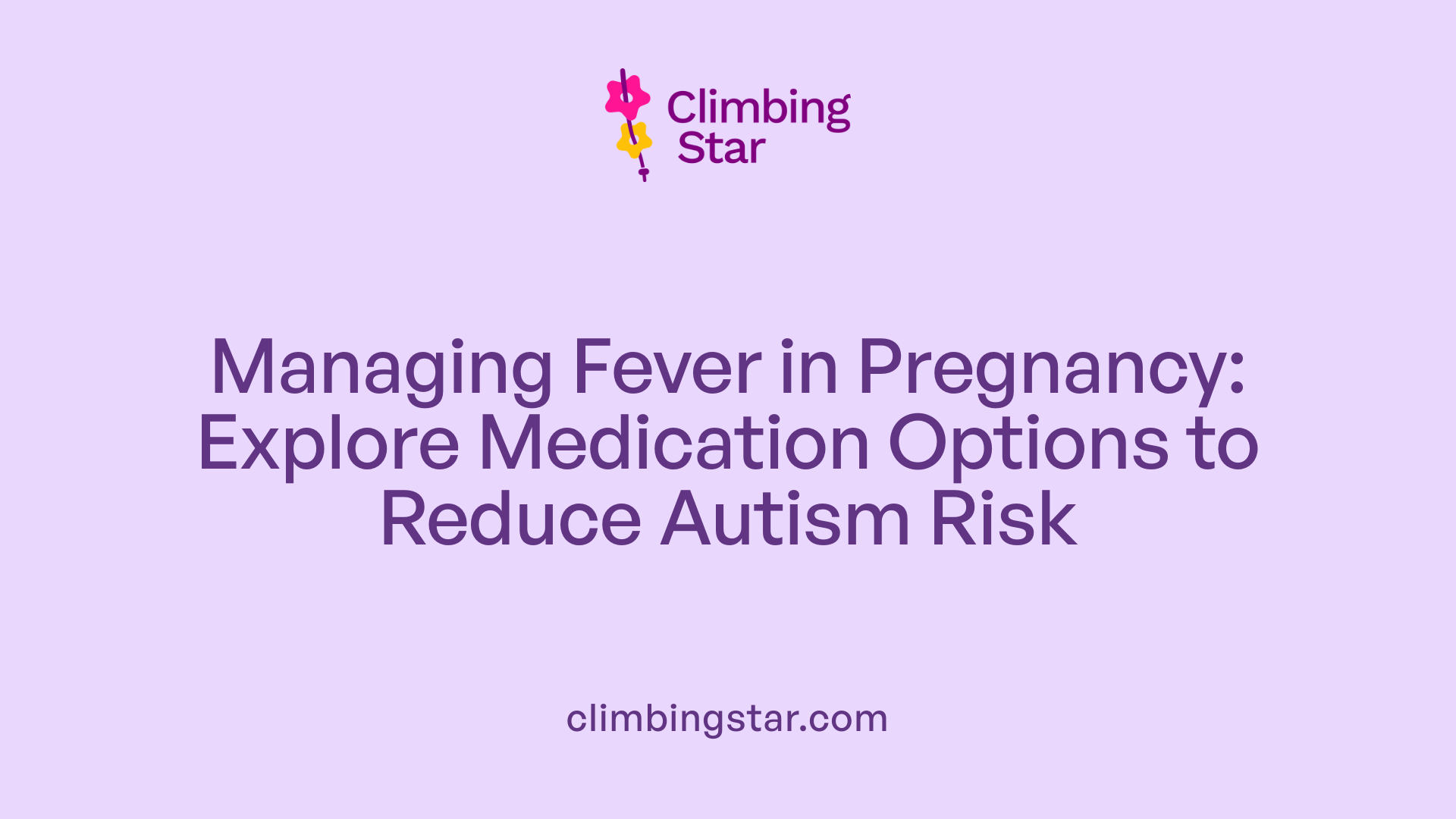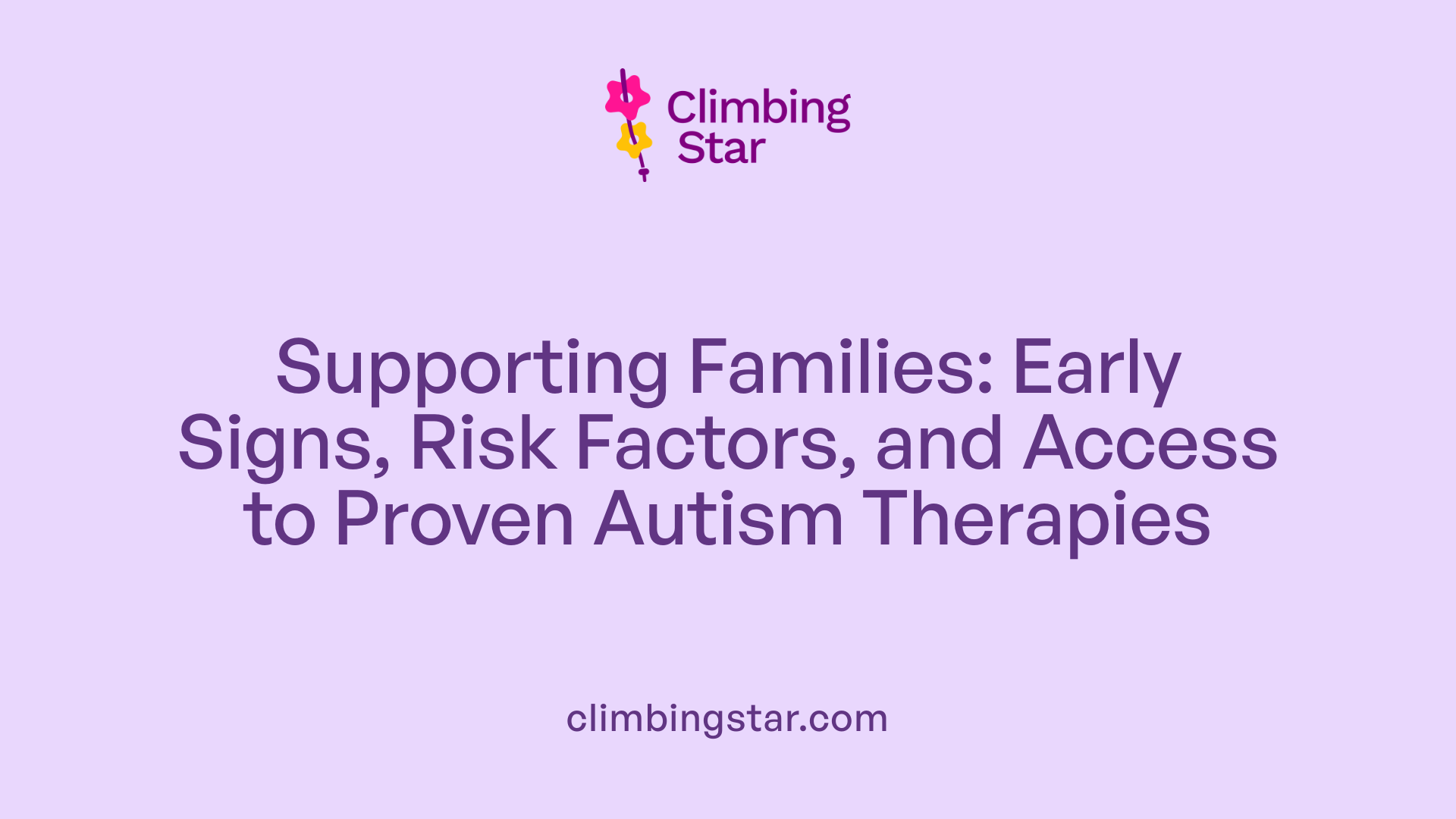Exploring the Connection Between Maternal Fever and Autism Spectrum Disorder Risk
Recent research highlights significant links between prenatal exposure to maternal fever and an increased risk of Autism Spectrum Disorder (ASD) in children. This article delves into the latest study findings on how timing and frequency of fever episodes during pregnancy influence ASD risk, shedding light on immune responses as critical factors. We also explore widely used therapies like Applied Behavior Analysis (ABA) to understand their role in supporting individuals affected by ASD.
Understanding the Risk Factors: Maternal Fever During Pregnancy and Autism
How does maternal fever during pregnancy affect the risk of autism?
Prenatal exposure to maternal fever has been linked to an increased risk of Autism Spectrum Disorder (ASD) in children. Children born to mothers who experienced fever during pregnancy have about twice the risk of developing ASD compared to those whose mothers did not have fever, with an adjusted odds ratio of 2.02.
Association between maternal fever and increased ASD risk
Recent studies show a clear statistical association between fever in pregnancy and ASD risk. Fever reported at any time during pregnancy was associated with a 34% increase in ASD risk. Notably, fever episodes during the second trimester increased the odds by 40%, while fever in the third trimester presented an even stronger association—an adjusted odds ratio of 2.70—indicating about a 2.7 times higher risk.
Timing of fever exposure and its impact on ASD risk
The timing of maternal fever is crucial. Fever in the third trimester is particularly linked to elevated ASD risk, suggesting that later stages of prenatal development may be more vulnerable to adverse immune effects. Additionally, the risk amplifies with the number of fever episodes after the twelfth week of pregnancy: one or two episodes increased ASD risk by 1.3 times, while three or more episodes elevated the risk more than threefold (3.12 times).
These findings highlight the importance of immune responses during pregnancy and their potential role in contributing to ASD. While infections themselves, such as genitourinary infections or influenza, were not significantly associated with ASD, it is specifically the fever response that may drive the increased risk.
Efforts to study this association in diverse populations, including low-income, urban minority groups, and adjustments for confounding factors strengthen the reliability of these conclusions. Understanding these relationships aids in focusing future research and prevention strategies on managing maternal fever during pregnancy to reduce ASD risk.
Frequency and Timing: How Fever Episodes Influence Autism Risk
Does the number and timing of fever episodes during pregnancy influence autism risk?
Research shows that both the number and timing of maternal fever episodes during pregnancy significantly impact the risk of Autism Spectrum Disorder (ASD) in children. Specifically, the risk increases with more frequent fevers after the twelfth week of pregnancy. One or two fever episodes raise ASD risk by about 1.3 times, while experiencing three or more episodes more than triples the risk, with an adjusted odds ratio of 3.12.
How does risk vary by trimester?
The trimester during which fever occurs is a crucial factor. Fever during the second trimester increases the odds of ASD by 40%. This risk jumps considerably if the fever occurs in the third trimester, where the adjusted odds ratio rises to 2.70. These findings highlight that later stages of pregnancy might be more vulnerable to immune challenges that influence neurodevelopment.
What does this mean for understanding autism risk?
The data suggests a dose-response relationship where both frequency and timing of fever episodes matter. More frequent fevers, especially in the latter half of pregnancy, correspond with a heightened risk of ASD. This supports the hypothesis that maternal immune responses—triggered by fever rather than infection alone—may play a critical role in autism development.
Focusing on fever episodes in pregnancy provides insight into environmental factors that could contribute to ASD, and underscores the importance of monitoring and managing maternal fever carefully during this sensitive period.
Distinguishing Fever from Infection: What Drives Autism Risk?

Is it the infection or the fever during pregnancy that increases autism risk?
Recent research highlights a crucial distinction between maternal infection and fever regarding autism spectrum disorder (ASD) risk. The study demonstrated no significant link between prenatal genitourinary infections or influenza and ASD. This suggests that the presence of infection itself may not directly elevate the risk.
Instead, the data point to fever—and the body's immune response to infection—as a more influential factor. Fever during pregnancy was associated with an increased ASD risk, with odds ratios rising notably with the number and timing of fever episodes. This implies that the inflammatory and immune processes triggered by fever could play a central role in affecting fetal neurodevelopment.
Understanding fever as a critical environmental factor shifts the focus to maternal immune activation rather than simply the infection. Addressing how fever modulates immune responses during pregnancy could provide deeper insight into ASD etiology and potential preventive strategies.
Population and Methodology: Robustness of the Autism and Maternal Fever Study
What population was studied and how reliable is the data on maternal fever and autism?
This study focused on a low-income, urban, minority population in the United States. Such groups are often underrepresented in autism spectrum disorder (ASD) research, making the findings especially valuable for understanding risks across diverse populations. Studying a cohort of 95,754 children born between 1999 and 2009, including 583 confirmed ASD cases, provided a substantial sample size to detect meaningful associations.
Study population demographics
The participants were predominantly from underprivileged and minority backgrounds, which enriches ASD research by addressing socioeconomic and ethnic diversity. These social determinants are crucial since ASD risk has been studied mainly in more advantaged populations previously.
Prospective data collection advantages
Maternal fever exposure during pregnancy was determined through self-reports collected shortly after birth. This prospective approach minimized recall bias commonly affecting retrospective studies, where delayed reporting can lead to inaccuracies. By capturing data promptly, the study ensures higher validity in linking prenatal fever records with ASD outcomes.
Control for confounding factors
The study's analysis accounted for an extensive range of potential confounding variables to isolate the impact of maternal fever on ASD risk. Adjustments included maternal education, marital status, race, maternal age, child’s sex, gestational age at birth, and maternal smoking habits. Such thorough controls enhance confidence that observed associations are less likely due to other underlying factors.
Overall, this research methodology provides robust, reliable insights into the relationship between maternal fever during pregnancy and increased ASD risk, especially relevant to populations often overlooked in epidemiological studies.
Immune Responses in Pregnancy: A Key to Understanding ASD Etiology
How might immune responses to maternal infection contribute to autism risk?
Maternal immune activation (MIA) during pregnancy, commonly indicated by fever, is increasingly recognized as a significant factor in autism spectrum disorder (ASD) development. Fever acts as a visible marker of an active immune response, during which the mother's body releases inflammatory cytokines and signaling molecules. These immune factors have the ability to cross the placental barrier and interact with the developing fetal brain.
Role of maternal immune activation in ASD development
When a mother's immune system responds to infection, it triggers a cascade of biological events. The inflammatory molecules can alter neurodevelopmental pathways by affecting processes such as neuronal growth, synapse formation, and brain circuitry regulation. Especially during critical periods such as the second and third trimesters, these disruptions can increase the likelihood of neurodevelopmental disorders like ASD.
Fever as a marker of immune response
Fever during pregnancy is not merely a symptom of infection but signals the activation of the maternal immune system. Studies have shown that maternal fever in the third trimester is associated with a roughly 2.7-fold increased risk of ASD in offspring, highlighting the timing and intensity of immune activation as crucial factors.
Possible biological mechanisms
The exact biological mechanisms remain under active investigation, but prevailing hypotheses suggest that inflammatory cytokines cross the placenta and affect fetal neural cells. This leads to altered brain development, possibly through mechanisms such as disruption of neural cell proliferation, migration, or synaptic pruning. These alterations may contribute to the behavioral and cognitive features observed in ASD.
Understanding how maternal immune responses influence fetal brain development offers vital insights into the etiology of ASD and suggests potential avenues for intervention and prevention in at-risk pregnancies.
Medication Use During Fever in Pregnancy and Potential Effects on Autism Risk

Can medications used to reduce fever during pregnancy lower autism risk?
Research exploring the relationship between fever medication use during pregnancy and autism risk is in early stages. Preliminary findings indicate that acetaminophen, a common fever reducer, may only slightly reduce the increased risk of Autism Spectrum Disorder (ASD) when used in the second trimester. This suggests that while acetaminophen might provide some benefit, it does not fully counteract the impact of maternal fever on ASD risk.
Interestingly, no ASD cases were reported among children whose mothers used ibuprofen during pregnancy. This observation hints at a potentially stronger protective effect from ibuprofen, a nonsteroidal anti-inflammatory drug (NSAID) that works differently from acetaminophen. However, this result is based on limited data and small sample sizes, making it premature to draw definitive conclusions.
Preliminary findings on fever mitigation
The study highlights that fever episodes during pregnancy — particularly multiple occurrences — are linked with higher ASD risk. Therefore, managing fever might be a valuable strategy to reduce this risk. However, the minimal mitigation observed with acetaminophen underscores the need to evaluate the effectiveness of different fever-reducing medications carefully.
Limitations of current data
The data regarding medication use during pregnancy and ASD risk remain limited. The small number of ibuprofen users and the observational nature of the research mean that confounding factors and biases cannot be entirely ruled out. Additionally, medication dosage, frequency, and timing were not thoroughly studied, which are crucial factors in understanding their impact on ASD risk.
In summary, current evidence cautiously suggests some influence of fever management medications on autism risk but emphasizes the necessity for more comprehensive research. Further studies will help determine whether specific medications during maternal fever can meaningfully reduce the likelihood of ASD in children.
Applied Behavior Analysis (ABA) Therapy: Foundations and Objectives
What is applied behavior analysis (ABA) therapy, and how is it used to address autism?
Applied Behavior Analysis (ABA) therapy is a scientific approach that applies principles of learning and behavior to promote positive changes in individuals with autism spectrum disorder (ASD). The main goal of ABA is to improve socially significant behaviors, such as communication, social skills, and adaptive functioning, while reducing challenging or negative behaviors.
Definition and core principles of ABA
ABA is grounded in behavioral psychology and uses reinforcement, prompting, and systematic teaching to shape behavior. The therapy involves carefully analyzing behavior and the environment to tailor interventions that motivate and help the child acquire new skills.
Behavioral goals targeted in autism treatment
ABA focuses on developing essential skills for daily living and interaction. This includes:
- Enhancing verbal and nonverbal communication
- Improving social skills such as sharing and cooperation
- Teaching self-care and adaptive behaviors
- Reducing disruptive or harmful behaviors
Examples of ABA methodologies
Several ABA-based methods are commonly used in autism treatment:
- Discrete Trial Training (DTT): Uses structured teaching with clear prompts and rewards, breaking skills into small steps.
- Pivotal Response Treatment (PRT): Emphasizes motivation and natural reinforcement to improve communication and social engagement.
- Early Start Denver Model (ESDM): Combines ABA principles with developmental approaches, targeting young children, and encouraging play-based learning.
Early intervention using ABA has been shown to significantly improve developmental trajectories for children with autism, making it a cornerstone of evidence-based autism therapy.
Providers of ABA Therapy: Qualifications and Roles
Who typically provides ABA therapy, and what qualifications do they have?
Applied Behavior Analysis (ABA) therapy is primarily provided by highly qualified professionals known as Board Certified Behavior Analysts (BCBAs). These individuals typically hold a master's degree in behavior analysis, psychology, education, or a related field. Beyond formal education, BCBAs complete specific coursework approved by the Behavior Analyst Certification Board (BACB), engage in supervised fieldwork to gain practical experience, and pass rigorous certification exams.
Therapists and technicians, often called Registered Behavior Technicians (RBTs), play a vital role in implementing the behavior intervention plans designed by BCBAs. RBTs generally have completed specialized training programs focused on behavior analysis principles and pass their own certification exam. Although they do not develop treatment plans, their role in delivering day-to-day therapy is crucial.
Educational and certification requirements
| Provider Role | Education Level | Certification | Additional Notes |
|---|---|---|---|
| Board Certified Behavior Analyst (BCBA) | Master's degree or higher | BACB Board Certification | Requires coursework, supervision, exam |
| Registered Behavior Technician (RBT) | High school diploma or higher | BACB RBT Certification | Focused on implementation under BCBA supervision |
Supervision and ongoing training
Effective ABA therapy depends on continuous supervision by BCBAs, who regularly oversee the work of RBTs and other therapists to ensure treatment fidelity and ethical delivery. BCBAs update treatment plans based on client progress and evolving needs. Both BCBAs and RBTs participate in ongoing professional development and training to stay current with advances in behavior analysis and best practices.
This layered system of qualifications, supervision, and training helps maintain high standards of care in ABA therapy, promoting tailored and effective treatment for individuals with Autism Spectrum Disorder and other behavioral challenges.
Behavioral Goals in ABA Therapy for Autism
What specific behavioral goals does ABA therapy target for individuals with autism?
ABA therapy focuses on a range of behavioral goals tailored to support individuals with autism spectrum disorder. One major goal is improving communication skills, which includes both expressive abilities (such as speaking or using alternative communication methods) and receptive skills (understanding spoken language). This enhancement helps individuals express their needs and understand others more effectively.
Social skills development is another critical target of ABA therapy. This involves teaching individuals how to engage in social interactions, recognize social cues, and participate in shared activities, facilitating better integration into social settings.
Reduction of problematic behaviors is also a primary goal. These behaviors might include repetitive movements, tantrums, or aggression, which can interfere with learning and socialization. ABA employs strategies to decrease such behaviors and replace them with more appropriate responses.
Finally, ABA therapy aims to develop daily living and adaptive skills, such as personal hygiene, dressing, eating independently, and other tasks that promote greater autonomy and quality of life.
By addressing these areas, ABA therapy supports comprehensive progress, helping individuals with autism lead more fulfilling lives through improved communication, social engagement, behavioral regulation, and independence.
Monitoring Progress and Adjustments in ABA Therapy
How is progress monitored and adjusted during ABA therapy?
In Applied Behavior Analysis (ABA) therapy, progress monitoring is a critical component to ensure the effectiveness of interventions. Therapists collect data systematically during each session, focusing on specific target behaviors and skill acquisition. This data, often recorded in real-time or immediately after sessions, tracks both the frequency and quality of behaviors.
Regular assessment occurs through periodic reviews—weekly or monthly—where therapists analyze the accumulated data. These assessments determine whether measurable goals are being met and help identify patterns or plateaus in learning.
When progress falls short of expectations, therapists modify the intervention. Adjustments may include changing the reinforcement strategy, increasing the intensity or frequency of sessions, or altering the teaching methods. Such modifications ensure the therapy remains individualized and responsive to the child's needs.
Why is continuous monitoring essential?
Continuous data collection and analysis promote evidence-based decision-making. This responsiveness allows therapists to optimize treatment, maximizing skill development and minimizing frustration. Without ongoing progress monitoring, therapy risks becoming outdated or ineffective.
In summary, progress in ABA therapy is closely tracked through systematic data collection, regular goal assessments, and timely intervention adjustments, creating a dynamic and personalized therapeutic process.
Criticisms and Challenges of ABA Therapy in Autism Treatment
What are the common challenges or criticisms of ABA therapy in treating autism?
Applied Behavior Analysis (ABA) therapy is one of the most widely used interventions for autism spectrum disorder (ASD). Despite its prevalence, it has faced numerous criticisms and challenges from both professionals and the autism community.
One major concern revolves around the intensity of ABA therapy. Often requiring many hours per week, such intensive therapy can be overwhelming and stressful for some individuals with autism, who might find the constant demands taxing or anxiety-provoking.
Another challenge is the need for highly trained and ethically grounded providers. ABA therapy relies heavily on behavioral techniques that must be applied carefully to avoid harm. Some past practices involved aversive methods meant to reduce unwanted behaviors, leading to controversy and ethical concerns. Although modern ABA approaches emphasize positive reinforcement and respectful intervention, this legacy still influences perception.
Debates also arise around autonomy and acceptance. Critics argue that ABA may focus too strongly on compliance and "normalizing" behaviors, which could inadvertently undermine the individual's autonomy and fail to embrace neurodiversity. Many advocates stress the importance of respecting the unique experiences and identities of people with autism rather than trying to "correct" them.
In summary, while ABA therapy has demonstrated benefits, it must be delivered thoughtfully, with sensitivity to the individual's needs and preferences. Ongoing discussions about ethical practices, provider training, and balancing behavioral goals with acceptance continue to shape the evolution of ABA treatment.
Implications of the Fever-ASD Link for Early Screening and Intervention

How might the association between maternal fever and autism influence early screening and intervention?
The established connection between maternal fever during pregnancy and an increased risk of Autism Spectrum Disorder (ASD) offers important opportunities for medical professionals to improve early screening processes. Knowing a child was exposed to maternal fever, particularly during critical periods like the second and third trimesters, may serve as an early warning sign that prompts healthcare providers to closely monitor developmental milestones.
Potential for prenatal fever history in risk assessment
Integrating maternal fever history into prenatal and postnatal risk assessments can help identify children at elevated risk for ASD. Data indicates that maternal fever, especially multiple episodes after the twelfth week, raises the likelihood of ASD significantly. Therefore, documenting this history allows clinicians to tailor follow-up care and developmental evaluations accordingly.
Importance of early autism screening
Early identification of ASD improves the chances for effective support. Screening tests administered during infancy or toddlerhood can be prioritized for children with reported prenatal fever exposure. This timely detection is crucial since intervention during the earliest stages of development supports better cognitive and social outcomes.
Benefits of early therapeutic intervention
Once a child is identified as at-risk or showing early signs of ASD, interventions such as Applied Behavior Analysis (ABA) therapy can begin promptly. Early therapeutic efforts capitalize on neuroplasticity to promote better communication, social skills, and adaptive behaviors. The recognition of maternal fever as a risk factor highlights the potential to start these interventions sooner, offering the best opportunity for improvement.
Understanding the link between prenatal fever and ASD allows healthcare systems to refine screening strategies and intervention timing. This proactive approach supports families and improves developmental trajectories for children at risk.
Broader Environmental and Social Context of ASD Risk Factors
Why is it important to study autism risk factors in diverse populations?
Research into Autism Spectrum Disorder (ASD) often lacks sufficient inclusion of diverse socioeconomic and ethnic groups. Studying ASD risk factors within underserved, low-income, urban, and minority populations is essential for several reasons. First, it ensures that scientific findings are more generalizable and applicable across different demographic groups. These populations frequently face unique environmental exposures and social stressors that might influence ASD risk differently than in more studied groups.
Additionally, inclusive research practices address ongoing health disparities by capturing a broader range of genetic predispositions and environmental influences. This comprehensive approach can improve early diagnosis accuracy and tailor intervention strategies to meet the needs of diverse communities.
The referenced study, conducted in a low-income, urban, minority population in the United States, represents an important step in this direction. By incorporating data from populations often underrepresented in ASD studies, it enriches our understanding of how prenatal factors such as maternal fever may contribute to ASD risk broadly rather than in select groups. This inclusive perspective aligns with the growing recognition that social determinants and environmental context play critical roles in neurodevelopmental outcomes.
In summary, research in diverse populations enhances the robustness of ASD risk factor identification and supports equitable health practices for all affected groups.
Future Directions in Research: Immune Activation and Autism Prevention
What future research is needed regarding maternal fever and autism?
The association between maternal fever and increased risk of Autism Spectrum Disorder (ASD) underlines the importance of exploring maternal immune responses during pregnancy. Future studies should focus on clarifying the biological mechanisms by which maternal fever and immune activation contribute to ASD development in offspring. Understanding how fever-induced inflammation affects fetal brain development could reveal critical intervention points.
Investigating maternal immune responses
Research is needed to dissect the complex immune pathways involved in maternal fever episodes, especially during the second and third trimesters. Identifying specific inflammatory markers or immune signaling molecules linked to ASD risk could help pinpoint which immune responses are harmful and which might be protective.
Potential interventions to reduce ASD risk
Another priority for future research is evaluating whether antipyretic medications, like acetaminophen or ibuprofen, can safely mitigate the risk of ASD associated with maternal fever. Preliminary data suggest minimal risk reduction with acetaminophen and possible protective effects with ibuprofen, but larger, controlled studies are necessary to confirm these findings. Additionally, exploring alternative interventions that modulate immune activation during pregnancy may offer novel prevention strategies.
Need for further studies on fever and medication effects
Further investigation is warranted to understand the timing, frequency, and severity of fever episodes in relation to ASD risk and how these factors interact with medication use. Identifying optimal management strategies for maternal fever without adversely affecting pregnancy outcomes could contribute significantly to ASD prevention efforts.
Overall, expanding research in these areas holds promise for unveiling mechanisms of ASD etiology linked to prenatal immune activation and for developing safe preventive measures to reduce the incidence of ASD in future generations.
Integrating Etiological Insights into Therapeutic Practices
How can understanding prenatal risk factors inform autism therapies?
Research identifying prenatal factors like maternal fever as increasing the risk of Autism Spectrum Disorder (ASD) underscores the importance of early risk recognition. Knowing that immune responses during pregnancy may influence ASD development provides clinicians and families with critical context to initiate timely evaluations and interventions.
Translating research on prenatal risk factors into treatment approaches
By integrating knowledge about prenatal risks, healthcare providers can better tailor early intervention plans. Children with known prenatal exposures may benefit from monitored developmental screenings to identify any challenges early. This proactive approach allows earlier deployment of therapies designed to mitigate ASD symptoms before they fully manifest.
Role of behavioral therapies in addressing ASD
Behavioral interventions such as Applied Behavior Analysis (ABA) remain cornerstones of ASD treatment. Leveraging etiological insights, these therapies can be customized to address specific neurodevelopmental patterns linked to prenatal exposures. Customized behavioral programs can help improve communication, social skills, and adaptive behaviors.
Importance of multidisciplinary care
Optimal outcomes often require a comprehensive, multidisciplinary care model combining behavioral therapy, medical management, and developmental support. Understanding prenatal factors enhances collaboration among pediatricians, neurologists, therapists, and educators to address each child's unique needs holistically. This cohesive strategy maximizes developmental progress and quality of life.
In summary, growing evidence on prenatal risk factors like maternal fever enhances our ability to provide personalized and timely interventions for ASD. Such integrative therapeutic practices bolster the efficacy of behavioral programs within a supportive medical and developmental framework.
Supporting Families: Education and Resources on Autism Risk and Treatment

How Can Families Be Supported Regarding Autism Risk and Therapy Options?
Supporting families begins with educating them about prenatal risk factors, such as maternal fever during pregnancy, which research has linked to an increased risk of Autism Spectrum Disorder (ASD). By understanding these risks, parents can be more alert to early developmental signs and seek timely evaluations.
Informing Parents About Prenatal Risks
Parents benefit from clear information on factors like fever during pregnancy, especially in the second and third trimesters, that may elevate ASD risk. Knowledge about the association between repeated fever episodes and heightened risk helps families recognize the importance of prenatal health monitoring.
Guidance on Early Signs and Seeking Therapy
Families should be guided to observe early signs of ASD, such as delayed speech or social difficulties, enabling prompt consultation with healthcare providers. Early diagnosis allows for initiation of evidence-based interventions, including Applied Behavior Analysis (ABA), which improves developmental outcomes.
Availability of Qualified ASD Intervention Providers
Facilitating connections to qualified ASD intervention providers is crucial. Families benefit from access to therapists trained in effective treatments like ABA. This support network empowers families to make informed decisions and provide early intervention, which is critical to maximizing a child's potential.
Providing comprehensive education and accessible resources fosters family confidence and promotes proactive steps toward managing ASD risk and therapy options.
Summarizing the Link Between Prenatal Fever and Autism, and the Role of ABA Therapy
Current research underscores that maternal fever during pregnancy, particularly when frequent or occurring in later trimesters, significantly elevates risk for Autism Spectrum Disorder. These findings emphasize the critical role of maternal immune activation in ASD etiology, calling for greater awareness among healthcare providers and families. While understanding risk factors is vital, early diagnosis and evidence-based interventions remain essential. Applied Behavior Analysis (ABA) therapy continues to provide a structured, effective approach to support individuals with autism, targeting key behavioral skills and enhancing quality of life. Ongoing research into preventive measures and therapeutic innovations promises to improve outcomes further, offering hope for more personalized and compassionate care.







